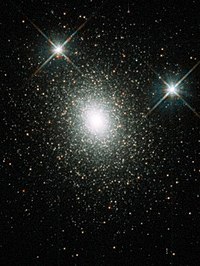
Photo from wikipedia
As the sensitivity of gravitational wave (GW) instruments improves and new networks start operating, hundreds of merging stellar-mass black holes (SBHs) and intermediate-mass black holes (IMBHs) are expected to be… Click to show full abstract
As the sensitivity of gravitational wave (GW) instruments improves and new networks start operating, hundreds of merging stellar-mass black holes (SBHs) and intermediate-mass black holes (IMBHs) are expected to be observed in the next few years. The origin and distribution of SBH and IMBH binaries in various dynamical environments is a fundamental scientific question in GW astronomy. In this paper we discuss the electromagnetic window provided by tidal disruption events (TDEs) of stars, into the assembly and merger of binary SBHs and IMBHs in nuclear star clusters (NSCs). We discuss how the host NSC mass and density and the slope of the black-hole mass function set the orbital properties and the masses of the binaries that undergo a TDE. For typical NSC properties, we predict a merger rate of $\sim 10^{-6}$--$10^{-7}\ {\rm yr}^{-1}$ per galaxy. The lightcurve of TDEs in NSCs could be interrupted and modulated by the companion black hole on the orbital period of the binary. The ejected mass associated with TDEs can produce optical transients of luminosity $\sim 10^{42}$--$10^{44}$ erg s$^{-1}$ over timescales of days to months. These should be readily detectable by optical transient surveys such as the Zwicky Transient Facility and LSST.
Journal Title: Monthly Notices of the Royal Astronomical Society
Year Published: 2020
Link to full text (if available)
Share on Social Media: Sign Up to like & get
recommendations!